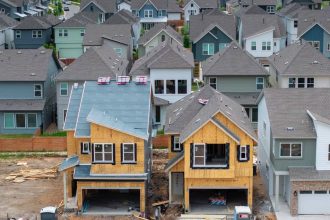Key takeaways
- Wildfires in the U.S. Northeast pose a “major threat,” according to a Moody’s report.
- A record-setting drought turned Northeast woodlands into tinderboxes at the end of 2024, creating a spike in wildfires.
- If wildfires become more common in the region, higher risk will put upward pressure on insurance premiums.
Liza Colburn was walking her dog in October when she saw something she had never before witnessed: smoke rising from an uncontained wildfire burning about a mile from her suburban Boston home. When night fell, she was able to see the flames.
The fire in the Blue Hills Reservation, 7,000 acres of state woodland straddling several towns on the border of Boston, was just one of 223 wildfires in Massachusetts that month. This is compared to an average of 15 for the month in prior years. It took several days for firefighters from more than a dozen towns and soldiers from the Massachusetts National Guard to contain it.
“It was unbelievable. It was like something you would see out West,” says Colburn.
In late 2024, a similar scenario unfolded across multiple Northeastern states like New York, New Jersey, Pennsylvania and Connecticut. Winslow Hansen, a fire and forest ecologist at the Cary Institute of Ecosystem Studies in upstate New York, noted that the regions experienced an unusually wet spring followed by a historic drought.
While the Northeast fires were smaller than the devastating blazes in Los Angeles last month, the climate pattern in an area of the country that normally experiences few wildfires is concerning. A drought that began in August created the driest autumn New England had seen in 50 years.
It’s not typical for the Northeast to have a drought that extends into autumn. We experienced what is being called ‘climate whiplash.’ We had a wet spring, which allowed a lot of new vegetation to grow, followed by a hot and dry summer and a warm and dry fall. This parched the landscape.
— Winslow Hansen
fire and forest ecologist, Cary Institute of Ecosystem Studies
Drought turns Northeast U.S. into ‘tinderbox’
After trees dropped their dead leaves at the end of the Northeast’s foliage season, it created “tinderbox conditions,” Hansen says.
The spike in Northeast wildfires came at the end of the warmest year on record. In fact, the planet’s 10 warmest years have all occurred in the past decade, according to National Oceanic and Atmospheric Administration data going back to 1850.
“Climate change has created hotter and drier conditions that are more conducive to longer and more severe wildfire seasons,” a report from the Congressional Budget Office explained. “Drought or abnormally dry weather leaves vegetation and plant debris drier and easier to ignite.”
No houses were reported lost in the Northeast fires, compared to the more than 10,000 homes consumed in the L.A. blazes. However, the 2024 spike in Northeast wildfires gives a dire warning to states that aren’t used to dealing with that type of hazard, Firas Saleh, director of product management for Moody’s, said in a December report.
“There are specific issues why wildfires in the more densely populated Northeast states pose a major threat,” said Saleh, including a lack of preparedness and a lack of experience in fighting them.
Wildfires potential impact on home insurance premiums
If the spike in Northeastern wildfires is a portent of future climate cycles, it could begin to impact home insurance premiums in those states as insurers account for an increase in risk, said Chris Low, chief economist at FHN Financial.
“Insurance premiums go up for two main reasons: higher losses and higher replacement costs,” Low says. “We’ve already seen increases everywhere because of post-pandemic inflation that made it more expensive to replace homes. If wildfires become more common in the Northeast, insurance will become more expensive and also harder to get — like in California.”
The average cost of homeowners insurance in the U.S. is $2,258 per year for $300,000 of coverage, according to February 2025 data from Quadrant Information Services. Home insurance policies typically include coverage for wildfires, and many also include “loss of use” provisions that help reimburse temporary housing expenses while homes are uninhabitable.
In areas where wildfires are common, such as California, insurance cancellation rates are rising as companies limit their loss exposure. As a result, some residents have been forced to switch to FAIR Plan coverage, which only covers catastrophic loss of the building — not its contents — and is sometimes more than double the cost of a standard home insurance policy. The FAIR Plan had 450,000 policies in force in 2024, up from 140,447 in 2018.
Last September, Insurance Commissioner Ricardo Lara announced an agreement with insurers that made it easier for them to get approval for rate hikes in return for a pledge to increase policies in neighborhoods prone to wildfires. After the devastating wildfire damage to Los Angeles neighborhoods in January, Lara prohibited insurers from canceling policies in the impacted areas for a year.
Home insurance discounts for mitigating fire risk
Northeast homeowners aren’t used to considering the impact a potential wildfire could have on their homes. In California, someone getting bids from contractors for a new roof would probably ask about fire ratings — especially if thinking about using asphalt shingles, the nation’s most common roofing material.
It’s a question that likely wouldn’t occur to a homeowner in a state where wildfires haven’t been common. Many asphalt shingles are rated Class A, indicating they are highly fire-resistant. Cheaper asphalt shingles might be rated Class B or Class C, meaning they are more likely to catch fire if embers land on the roof.
California requires home insurance companies to offer discounts to homeowners who have Class A-rated roofs, which include non-combustible metal and tile roofs. Wildfire mitigation discounts may also be extended for the clearance of a “defensible space” around the home — meaning removing shrubs and sheds in a 30-foot perimeter of a house and clearing vegetation and flammable items from under decks. However, mitigation discounts aren’t usually available to people insuring homes in states where wildfires are historically common.
Fire departments in wildfire-prone states like California have vast experience in fighting woodland blazes, and the California Department of Forestry and Fire Protection has its own fleet of water-dropping planes. In Northeastern states, firefighters have familiarity with extinguishing brush fires — smaller blazes that are easily controlled — but less experience in fighting uncontained forest fires.
States such as California invest billions of dollars annually in fire suppression and control with tens of thousands of active firefighters and extensive, sophisticated fire-fighting equipment to support them. This is not the case in the Northeast states.
— Firas Saleh
director of product management, Moody’s
Wildfire numbers ‘frankly staggering’
Near the end of October, Gov. Ned Lamont of Connecticut declared a state of emergency as the state’s drought reached a critical level. A few days earlier, a firefighter was killed while battling a wildfire on Lamentation Mountain in Berlin, about 10 miles south of Hartford. At least three other firefighters were injured. Crews from as far away as Quebec joined local fire departments to battle the blazes.
In early November, the Jennings Creek blaze burned about 5,300 acres on the border of New York and New Jersey. Again, one firefighter died and several others were injured. In total, wildfires tore through 11,000 acres in New Jersey last year, triple the acreage burned in 2023. In mid-November, New Jersey Gov. Phil Murphy said there had been 537 wildfires in the Garden State, compared to 37 a year earlier.“
The numbers are frankly staggering,” Murphy said at a press conference.
Read the full article here
















